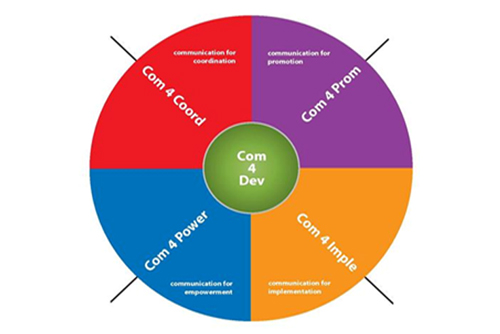Development communication refers to the use of communication to facilitate the development of society. It includes stake holders, right from target population to policy makers. It has two primary roles- the transforming role, as it leads to social change in today’s competitive market and a socializing role by seeking to maintain some of the established values of the society. Media plays an important role in development communication and with the advent of new media the reach is wider and faster. But it needs to be used extensively and tactfully for positive development purpose. One needs predictive analytical skills to choose and use media for development communication.
The approach to Communication for Development (C4D) has evolved over the years. Initially developed after World War II as a tool for diffusion of ideas, communication initiatives primarily involved a one-way transmission of information from the sender to the receiver. This includes large scale media campaigns, social marketing, dissemination of printed materials, and ‘education entertainment’. Since then, C4D has broadened to incorporate interpersonal communication: face-to-face communication that can either be one-on-one or in small groups. This came alongside the general push for more participatory approaches to development and greater representation of voices from the South. The belief is that while mass media allows for the learning of new ideas, interpersonal networks encourage the shift from knowledge to continued practice.
Communication for development has thus come to be seen as a way to amplify voice, facilitate meaningful participation, and foster social change. The 2006 World Congress on Communication for Development defined C4D as ‘a social process based on dialogue using a broad range of tools and methods. It is also about seeking change at different levels including listening, building trust, sharing knowledge and skills, building policies, debating and learning for sustained and meaningful change’. Such two-way, horizontal approaches to communication include public hearings, debates, deliberations and stakeholder consultations, participatory radio and video, community-based theatre and story-telling, and web forums.[1]
It encompasses access to and exchange of information, dialogue, creation of knowledge and open access to knowledge, development communication, strategic communication, participatory communication, expressive culture, media, information and communications infrastructure and technologies.
C4D recognises that communication processes often reflect power relations and aims to address this by enabling people’s capacities to understand, negotiate and take part in decision-making that affects their lives.
The growing interest in this sector lead to the first World Congress on Communication for Development organized by the FAO ComDev Team, The World Bank and The Communication initiative in Rome, Italy, in October 2006.
Communication for Development is built around four axes:
 The four axis of Communication for Development
The four axis of Communication for Development
Source: Wikipedia on development communication
- Com 4 Prom: Communication for Promotion promotes development aid in donor countries to justify how and why development aid resources are spent.
- Com 4 Imple: Communication for Implementation facilitates the implementation of development aid on developing countries by explaining development programmes to local populations.
- Com 4 Power: Communication for Empowerment gives power to local population to report on the implementation of the development aid they receive from donor countries.
- Com 4 Coord: Communication for Coordination allows donor entities to coordinates their activities on a global scale through a series of coordination tools and rules.
glocalisation, communications vs communication, everyday vs professional communication, practical vs theoretical knowledge, beyond behavior change and research orientation. WHO says that it is those who write or produce programmes on issues related to development are called development communicators. The teachers, scientists and extensionists in State Agricultural Universities are development communicators in varied fields of agriculture and allied sectors and they should be self-reliant in application of development communication.
New media technologies have also been put to serious use for development communication. Interactivity, narrative, instant feedback and persuasion capability are used to rope in common person into the process of development through the new media. Websites and blogs, streaming audio and video, chat rooms, social media and sharing platforms, apps etc., are some on the list of new media technologies using for development communication. They possess the character of
- the creation of new textual experiences,
- the arrival of new ways of representing the world,
- the development of new relationships between users and consumers and media technologies,
- the development of new patterns of organization and production
- The qualitative and quantitative analysis of impact of new media on stakeholders is possible through built in metrics available with the technology. Indicators such as page views, clicks, ratings, visitor engagement rate, conversions rate, distributions, sharing, ROI etc., can be tracked, aptly applying measuring tools and techniques. They can also be benchmarked for competitive advantage of development communication. These indicators mentor and monitor, the instantaneous progress of the approach and provides directions for future endeavor.

